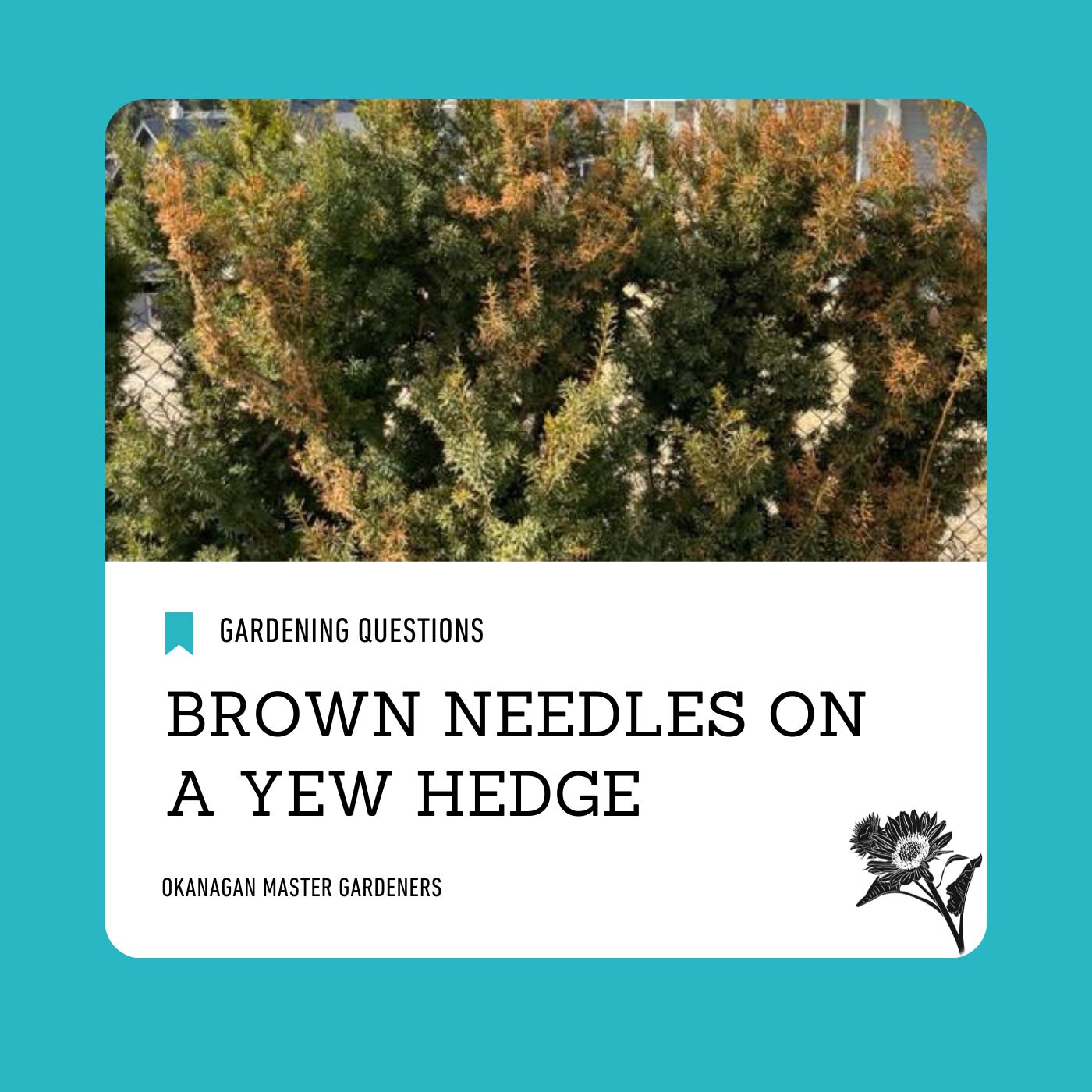This week's question is all about brown needles on a yew hedge.
Question
I have a hedge of yews along the edge of our swimming pool. Unfortunately, a landscaper planted them and I know that they are sitting in a lot of rock and very little soil as we live in Wilden but now, after 10 years, they were just starting to gain some height.
Last summer, the 2 shrubs at one end started to have white tips on the end. I wasn’t sure if they were too dry (as they have always been irrigated) or if they have some kind of disease. I have been away this winter and now notice that many of the branches are completely brown.
This hedge has survived 10 years of being munched on by deer and the heat dome of 2021, and all of the other extremes here. So far, all of the other yews are fine but I am afraid that I will lose these. What can I do?
Answer
As a general observation, these yews seem to be quite small and uneven for 10+ year-old shrubs. This may indicate that they are not thriving, potentially due to insufficient water/nutrients and environmental stresses.
Wounds from deer browsing could create entry points for disease pathogens, but it seems more likely that shallow rooting is perhaps a contributing factor. Yews like fertile soil, consistent moisture, and good drainage. From your description, the cause of the brown needles could be water stress. In general, soil and/or water issues are more common than insects and diseases.
As you mentioned, there is likely little soil between the surface and the underlying bedrock. I’ve not been to Wilden, but from a map, it looks like an escarpment, likely with near-surface bedrock and scree deposits. It is possible that the topsoil that is there is both very shallow and does not contain much in the way of organic matter. It’s a shame that the landscapers didn’t work some organic matter into the soil before planting.
Shallow topsoil is easily compacted during the construction of adjacent new homes, in-ground structures like pools, roads, fences, and utilities. Shallow topsoil is also quite prone to drought (especially on exposed slopes). The exposure of a hilltop can also stress plants, particularly in the form of sun and wind. Shallow topsoil layers dry out quickly in the sun, potentially causing drought stress. Winter winds can desiccate the short needles of these evergreens, especially at the tips of each branch.
The root zone of the yews is also limited as they are along the edge of a swimming pool. Assuming the pool is sealed, its perimeter limits the dimensional volume of soil from which the plants can receive water or nutrients.
It would be worth closely inspecting the irrigation system. Sometimes irrigation systems seem to be on but are not actually putting out as much water as expected/needed. Alternatively, a leak can cause water to pour out of the system in one limited area.
Yews can sometimes be deficient in iron, particularly in alkaline soil. Without a test, you could try a liquid iron fertilizer.
Here are some remedial measures you could consider:
- Inspect the irrigation system to check that it is working as intended
- Inspect the bases of the plants to check that the trunk is exposed to the air, with no soil/mulch against the bark
- Inspect the soil by digging a few test holes in the soil adjacent to the shrubs if possible (is it overly dry or wet? is landscape fabric present?)
- Water the plants deeply, by hand, if the soil is dry (and check to confirm the top 8 inches of soil is moist afterward)
- Trim off the brown branches back to green growth and remove the trimmings
- Apply a slow-release evergreen fertilizer to the soil, and consider a supplemental iron fertilizer product
- Place a layer of organic mulch on the soil around the shrubs (about 2 inches thick, but keep it about 6 inches away from the trunks themselves)
Keep an eye on soil moisture as spring temperatures rise. If fertilizing in the spring and adjusting/increasing the amount of water appears to be successful, consider applying fertilizer again in late summer. You’ll also want to keep watering whenever the top few inches of soil dry out (even in the fall until the ground is frozen solid).
Hopefully, these remedial measures can help these maturing plants, even if they weren’t placed optimally. Please let us know if you discover anything unexpected during your inspections of the irrigation/plants/soil and have follow-up questions.
Answer by:
Volunteer Master Gardener Advisor
Okanagan Master Gardeners
A chapter of the Master Gardeners Association of British Columbia
References:
- Master Gardener Manual, Washington State University (https://pubs.extension.wsu.edu/master-gardener-manual-printed-copy)
- OMG BTC Supplemental Materials: Nutrient deficiencies and fertilization of landscape plants
- Manual of Woody Landscape Plants: Their Identification, Ornamental Characteristics, Culture, Propagation and Uses, by Michael A. Dirr
